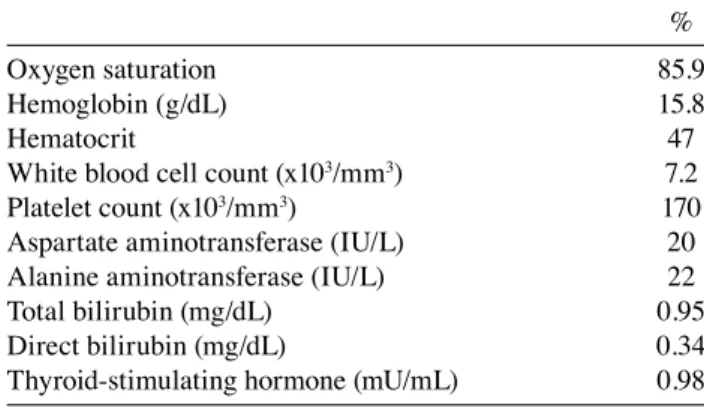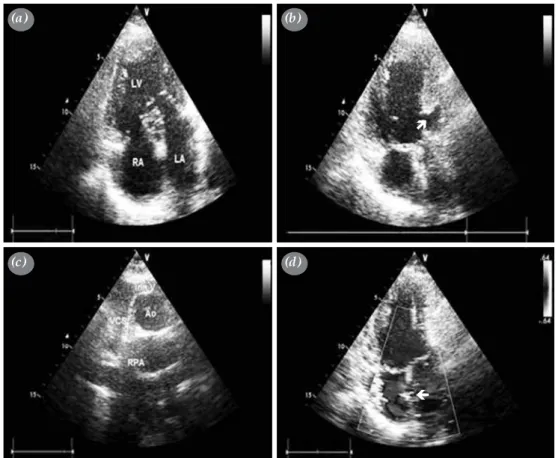1023 doi: 10.5606/tgkdc.dergisi.2013.7276
Türk Göğüs Kalp Damar Cerrahisi Dergisi 2013;21(4):1023-1026
Case Report / Olgu Sunumu
The classic Glenn operation in the double inlet left ventricle:
a 20-year follow-up
Çift girişli sol ventriküllü olguda klasik Glenn ameliyatı: 20 yıllık takip
Berkay Ekici,1 Handan Ünsal,2 Ziya Apaydın,1 Enver Ekici,2 Coşkun İkizler31Department of Cardiology, Medical Faculty of Ufuk University, Ankara, Turkey 2Department of Pediatric Cardiology, Medical Faculty of Ufuk University, Ankara, Turkey 3Department of Cardiovascular Surgery, Medical Faculty of Ufuk University, Ankara, Turkey
Fonksiyonel tek ventriküllü kalp nadir görülen, karma-şık bir doğuştan anomalidir. Prognozu cerrahi girişim olmadan genellikle kötüdür ve yetişkinlik döneminde de uzun süreli yaşam nadirdir. Bu yazıda çift girişli sol ventrikül, valvüler pulmoner stenoz, sol ön rudimenter sağ ventrikül, ventriküler septal defekt, diskordan vent-riküloatriyal bağlantı, patent foramen ovale ve Glenn şantı olan ve 20 yıl takip edilen 57 yaşında kadın bir olgu sunuldu. Kardiyak kateterizasyonda klasik Glenn şant anatomisi gösterildi. Hasta şu an medikal tedavi ile izlenmektedir.
Anah tar söz cük ler: Doğuştan kalp defekti; fonksiyonel tek vent-rikül; Glenn şant.
Functional univentricular heart is a rare and complex congenital anomaly. The prognosis is usually poor without any surgical intervention and long-term survival is rare. In this article, we report a 57-year-old female case with a double inlet left ventricle with valvular pulmonary stenosis, left anterior rudimentary right ventricle, ventricular septal defect, discordant ventriculoatrial connection, patent foramen ovale and Glenn shunt who was followed for 20 years. Cardiac catheterization revealed a classic Glenn shunt anatomy. The patient is currently under follow-up with medical treatment.
Key words: Congenital heart defects; functional single ventricle; Glenn shunt.
Functional single ventricle (FSV) is a congenital anomaly that is defined as the presence of a univentricular chamber or two ventricular chambers in which one of the ventricles is severely rudimentary. Other problems associated with FSV are pulmonary stenosis (PS) or atresia, subaortic stenosis, coarctation of the aorta, and atrioventricular valve atresia.[1] Thus, many anatomical subtypes and variations exist. Neonates with FSV have very high morbidity and mortality rates, making them candidates for surgical repair. Patients who do not undergo palliative surgery have a median survival rate of 14 years, and survival into late adulthood without surgical palliation has been rarely reported.[2] We present the case of a 57-year-old female who was operated on using the classic Glenn shunt technique 20 years ago.
CASE REPORT
A 57-year-old female who had surgery in 1992 because of FSV was recently admitted to our clinic with dyspnea, fatigue, palpitation, hemoptisia, and cyanosis with effort. Central cyanosis had been diagnosed when she was 10 years old, but her family did not seek medical attention for socioeconomic reasons. The patient had a history of normal vaginal delivery when she was approximately 18, 20, and 25 years old and was incorrectly diagnosed with rheumatic heart disease during her last pregnancy. In 1992, she was admitted to a cardiology clinic for the evaluation of cyanosis at the age of 37. At that time, transthoracic echocardiography (TTE) showed double inlet left ventricle (DILV) with PS, left anterior rudimentary right ventricle (RRV), ventricular septal defect (VSD),
Received: June 29, 2012 Accepted: October 09, 2012
Correspondence: Berkay Ekici, M.D. Ufuk Üniversitesi Tıp Fakültesi, Kardiyoloji Anabilim Dalı, 06520 Balgat, Ankara, Turkey.
Tel: +90 312 - 481 90 73 e-mail: berkay.ekici@gmail.com Available online at
www.tgkdc.dergisi.org
doi: 10.5606/tgkdc.dergisi.2013.7276 QR (Quick Response) Code
Turk Gogus Kalp Dama
1024
discordant ventriculoatrial (VA) connection, and patent foramen ovale (PFO), and cardiac catheterization confirmed the echocardiographic images. Furthermore, in 1992, the laboratory results showed a mean pulmonary artery (PA) pressure of 12 mmHg, an aortic pressure of 120/80 mmHg, a left ventricle (LV) pressure of 120/0-7 mmHg, left and a right atrium (RA) pressure of 8 mmHg. In addition, the patient’s pulmonary systemic flow ratio (QP/QS) was 1.3, and her pulmonary vascular resistance (PVR) was 1.13 wood units. The patient was operated on via the classic Glenn procedure, and the postoperative arterial oxygen saturation increased by 10 mmHg. Since 1992, the patient has been controlled with medical therapy. At the last follow-up visit, the patient’s blood pressure was 120/70 mmHg, and her heart rate was 86 beats per minute. Her functional capacity was class II according to the New York Heart Association (NYHA) classification. Minimal cyanosis was seen on the tongue and lips on exertion. On cardiac auscultation, the patient had a class II/VI systolic ejection murmur. The most audible sound was over the second left intercostal space, and there was an accentuated second heart sound. The patient’s laboratory findings are shown in the Table 1. An electrocardiogram (ECG) revealed sinus rhythm, and nonspecific ST segment/T wave changes. In addition, a chest X-ray revealed a mild cardiomegaly. Furthermore, 24-hour ambulatory ECG monitoring detected 187 unifocal ventricular and 50 supraventricular extrasystoles. Transthoracic echocardiography was also performed, and it showed DILV with valvular PS (peak gradient: 85.29 mmHg; mean gradient: 45.49 mmHg), left anterior RRV, VSD, discordant VA connection, moderate right atrioventricular valve insufficiency, and PFO. The suprasternal short-axis view revealed the classic Glenn shunt (Figure 1). Cardiac catheterization was then performed, which also showed this shunt (Figure 2). The oxygen saturation (OS) of the aorta was 87%, and
the mean right-left PA pressures were 16 mmHg and 20 mmHg, respectively. Additionally, the patient’s PVR was 1.2 wood units at the right PA and 2.2 wood units at the left PA, and the Nakata index was 323 mm2/ m2. Furthermore, there was no arteriovenous fistula in the right lung fields. Metoprolol and acetylsalicylic acid were prescribed when she was discharged, and the patient comes for periodic follow-up visits twice a year. At the last follow-up evaluation, the patient’s NYHA class remained stable, and no significant disease progression was observed.
DISCUSSION
Double inlet LV is the most common form of FSV, and it represented 78% of the cases reviewed by Van Praagh et al.[3] In this abnormality, both atriums are connected to the LV. Usually there is an RRV, which can be located on the opposite side of the heart (i.e., corrected transposition). The arteries usually arise with the aorta from the right ventricle (RV) and the PA from the LV (transposition). Most of the patients with FSV suffer from dyspnea, cyanosis, and reduced exercise tolerance, and the survival rate is only 30% for the first year of life without palliative surgery. The clinical presentation and prognosis depend on the presence or absence of an obstruction to the pulmonary blood flow along with the level of PVR. If severe PS is present, it leads to severe oxygen desaturation. Most of these patients either receive surgical treatment or die during infancy. Moderate PS causes little or no heart failure, mild cyanosis, and no pulmonary arteriolar disease.[2] Superior vena cava (SVC)-to-right PA anastomosis, more commonly known as the classic Glenn shunt procedure, has been performed on patients with diverse cyanotic congenital heart disease to improve pulmonary blood flow. However, this procedure provides perfusion of only the right lung fields rather than an arteriovenous mixture. In addition, it is less likely to engender pulmonary vascular obstructive disease than systemic-PA shunts; hence, the risk for PA distortion is substantially less. The Glenn shunt is a palliative procedure that serves as a preliminary step to the Fontan operation.[4] Nowadays, the bidirectional Glenn shunt (BDG) has become a mainstay in the palliation of FSV. This is an operation that diverts systemic venous return from the SVC directly to both lungs through the right PA, thus bypassing the RRV. The advantages of the BDG include remission of the volume load on the FSV, the avoidance of PA distortion after PA banding or shunts, the facilitation of the eventual Fontan circulation, and the possible prevention of pulmonary vascular disease that can result from prolonged left-to-right shunting.
Table 1. Baseline laboratory findings of the patient %
Oxygen saturation 85.9
Hemoglobin (g/dL) 15.8
Hematocrit 47
White blood cell count (x103/mm3) 7.2
Platelet count (x103/mm3) 170
Aspartate aminotransferase (IU/L) 20
Alanine aminotransferase (IU/L) 22
Total bilirubin (mg/dL) 0.95
Direct bilirubin (mg/dL) 0.34
Ekici et al. Double inlet left ventricle
1025 In comparison with the classic Glenn shunt, BDG
provides bilateral pulmonary blood flow, thereby avoiding the mismatch that may occur between the SVC flow volume and the cross-sectional area of the entire right lung.[5]
Adult survival in patients with FSV who have not undergone palliative surgery is unusual, particularly in the latter decades of life. Survival is most common with balanced circulation, such as DILV with moderate PS. This combination of
Figure 1. (a) Echocardiogram showing double inlet left ventricle. (b) Left anterior rudimentary right
ventricle (marked by arrow). (c) Suprasternal short-axis view demonstrating the classic Glenn shunt
(superior vena cava-to-right pulmonary artery anastomosis). (d) Moderate right atrioventricular valve
insufficiency and patent foramen ovale (marked by arrow). LV: Left ventricle; RA: Right atrium; LA: Left atrium; Inn V: Innominate vein; SVC: Superior vena cava; Ao: Aorta; RPA: Right pulmonary artery;
(a) (c) (b) (d)
Figure 2. (a) Cardiac catheterization revealing the normal classic Glenn shunt procedure. (b) Selective
left pulmonary angiogram.
Turk Gogus Kalp Dama
1026
counteracting defects provides the perfect balance between the systemic and pulmonary blood flow and prevents the long-term sequelae that are normally seen with this condition. The first important defect is the ventriculo-arterial discordance since this allows for the preferential streaming of oxygenated blood from the left atrium into the systemic circulation. The second vital defect is a moderate degree of PS, which permits enough blood flow to the lung fields to prevent severe cyanosis while avoiding volume overload on the FSV from the shunting of excessive blood back into the PA.[6]
Our case was original in that the patient reached adulthood without receiving any medical therapy, and she was diagnosed in the third decade of life. It was also interesting that three gestation periods were completed without any complications before the diagnosis of her heart disease. The Fontan operation was not performed because our patient had undergone the Glenn anastomosis with additional antegrade pulmonary blood flow. She had a balanced circulation; therefore, we chose not to take this unnecessary risk. At her follow-up appointments, a lack of hemodynamic or functional abnormalities has been detected; thus, there has been no need for the Fontan procedure or any other corrective operation. The patient continues to do well, and she had normal laboratory findings at her last check-up.
As a result of this case, we believe that optimal palliation in patients of advanced age who have a complex, congenital cardiac disease is necessary, but the least risky procedure should be chosen. Therefore,
the Glenn shunt should be considered in patients who have FSV with balanced circulation.
Declaration of conflicting interests
The authors declared no conflicts of interest with respect to the authorship and/or publication of this article.
Funding
The authors received no financial support for the research and/or authorship of this article.
REFERENCES
1. Anderson RH, Cook AC. Morphology of the functionally univentricular heart. Cardiol Young 2004;14 Suppl 1:3-12. 2. Restaino G, Dirksen MS, de Roos A. Long-term survival in a
case of unoperated single ventricle. Int J Cardiovasc Imaging. 2004;20:221-5.
3. Vanpraagh R, Ongley PA, Swan HJ. Anatomic types of single or common ventricle in man. Morphologic and geometric aspects of 60 necropsied cases. Am J Cardiol 1964;13:367-86.
4. Sewell WH Jr, Glenn WW. Experimental cardiac surgery. I. Observation on the action of a pump designed to shunt the venous blood past the right heart directly into the pulmonary artery. Surgery 1950;28:474-94.
5. Hopkins RA, Armstrong BE, Serwer GA, Peterson RJ, Oldham HN Jr. Physiological rationale for a bidirectional cavopulmonary shunt. A versatile complement to the Fontan principle. J Thorac Cardiovasc Surg 1985;90:391-8.
6. Terada M, Watanabe H, Iino K, Kakizaki M, Takahashi M, Ito H. Adequate pulmonary stenosis allowed long-term survival in a patient with unoperated single ventricle. J Am Coll Cardiol 2012;59:e25.

